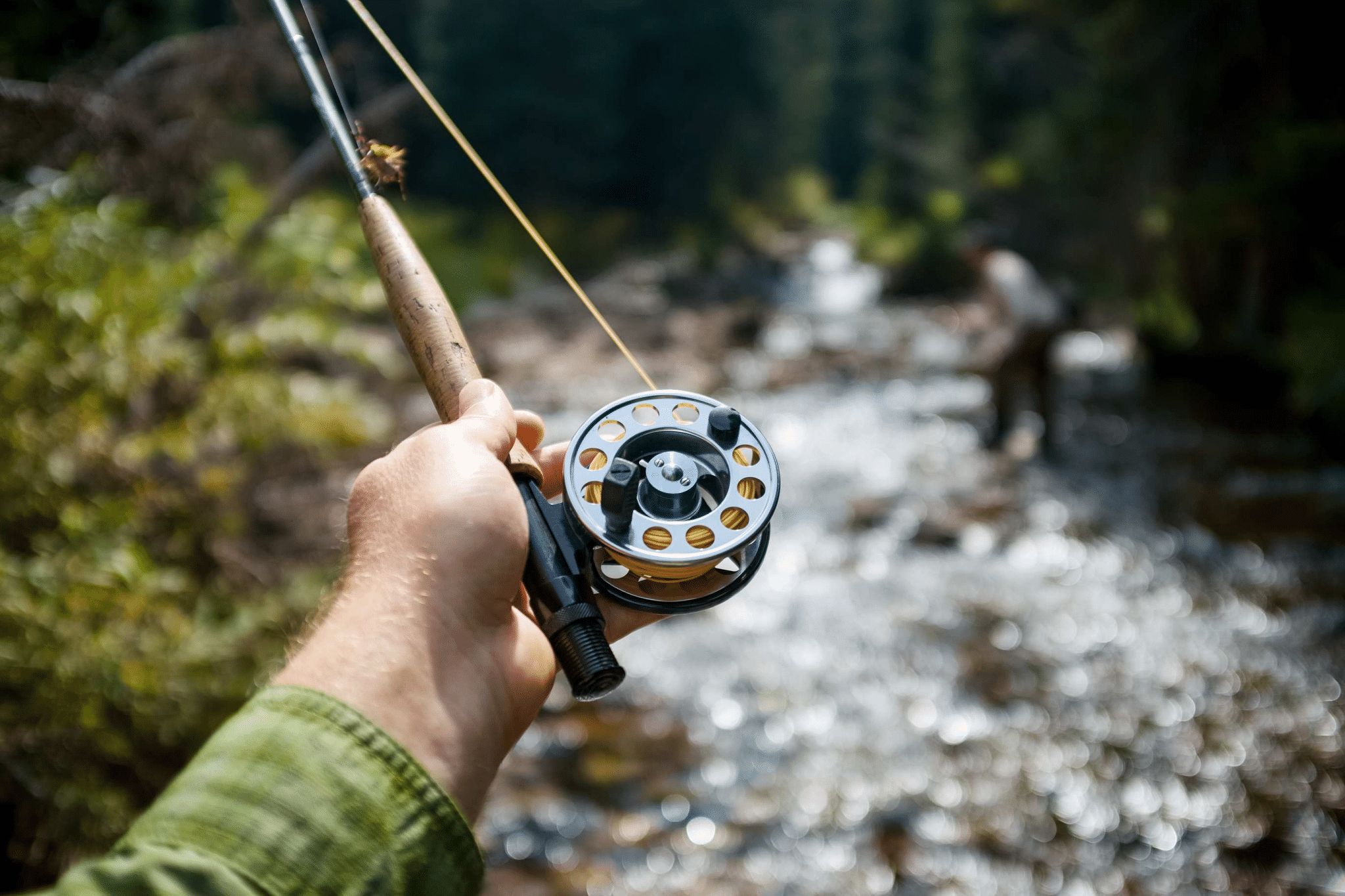Fly Fishing the Driftless

Fly Fishing the Driftless
Nick’s heart tightened as the trout moved. He felt all the old feeling….Ernest Hemingway, Big Two Hearted River Part I.
It is the Driftless region of Iowa. Located in the northeastern part of the state extending roughly from Manchester to the Minnesota border and east towards the great Mississippi, it is an area untouched by the last great glacial period. An area of rocky cliffs, rolling hills, and hardwood forests, it stands in stark contrast to the prairie landscape of the remaining part of the state. And it is the home of Coldwater streams teeming with brook, brown and rainbow trout.
Having been a fly fisherman for over thirty years, it was somewhat ironic that my passion had rarely taken more than a casual foray into northeastern Iowa. Most of my fishing had taken place in the western United States. That changed during an April trip taken with my long-time friend and pheasant hunting partner, Mark Radke of Aurelia, Iowa, who as a fly-fishing aficionado, had taken approximately sixty trips to the Driftless over the years. A less than promising weather forecast calling for constant rain dampened my enthusiasm for making the trip. Yet with Mark’s urging and eternal optimism, we decided to make the trek from western Iowa to
Decorah where we would concentrate our fishing on North Bear Creek near Highlandville.
Leaving my home in Lawton, Iowa at 5:00 AM and meeting Mark at his farm in Aurelia, we arrived at North Bear Creek midmorning and immediately began fishing. The surrounding terrain reminded me much of Pennsylvania or northern Michigan, and within minutes of casting, each of us landed brown trout.
While originally brown trout was brought in, it is now a naturally reproducing species that is no longer needing stocking in Iowa streams. It was encouraging that over the course of our trip we had an opportunity to land that many small browns, indicating a successful reproductive year. Kent Kleckner, a guide for Bear Creek Outfitters, encourages anglers to treat the brown almost as one would a hen pheasant- leave it alone and return it to the waters to allow for continued propagation. We encourage those wishing to keep fish for a meal to hold onto stocked rainbow trout that do not reproduce on Iowa streams.
The forecast of an 80% chance of showers gave way to partly sunny skies and a perfectly warm April day. Reading the stream and the hatch results in fishing nymphs most of the day with success being on the Hare’s ear, WD40, zebra midge, and the RS2. By early evening, the two of us had landed over forty fish and “educated” nearly the same number. Yet it was the beauty of our surroundings that I will most remember. The day allowed us to see bald eagles, pheasants, turkey, beaver, and even a small rattlesnake that swam nonchalantly in front of me.
Overnight showers muddied the waters but not our enthusiasm. Venturing to the Decorah Trout Hatchery, we met with Brian Malaise, Natural Resource Biologist for the Iowa DNR, for a stocking run and overview of the department’s trout habitat initiatives. Brian is an enthusiastic and staunch supporter of improving coldwater stream habitat and educated us on the science behind the department’s work in stocking and stream restoration. Only rainbow trout are currently stocked in Iowa’s streams. Brown and brook trout are established as naturally reproducing and while fingerling brook are introduced, only rainbow trout of catchable size are stocked. COVID-19 has changed the protocols for announcing stocking on Iowa streams.
Currently, all stocking is secret as it always has been on North Bear. Whether this continues after the pandemic is uncertain. 480 catchable rainbows with weekly stocking in North Bear. We traveled with Brian as he placed fish in the stream stretching from Highlandville to the Minnesota border. Tales I had heard of individuals following the DNR stocking truck were unfounded as we worked in relative solitude. Besides the trout hatchery in Decorah there are two others committed to the same mission located in Elkader and Manchester. It is the commitment of the Iowa DNR to preserve and protect coldwater streams of the Driftless and provide exceptional angling opportunities.
Following our trek we resumed fishing in the afternoon. Since the stream was just done stocking, we naively thought that we would be catching the new rainbows. This was not the case. A midafternoon hatch brought the browns to a frenzy and each of us lost count of how many fish we had to catch and release. A few sporadic rainbows were caught but it was the brown trout that carried the day. As afternoon began to wane, trout began to feed on the surface providing remarkable dry fly fishing opportunities. We reluctantly retreated to our truck, broke down our rods, and began our journey home, excited, content, and eagerly anticipating our next trip.
Fly fishing is a sport that is oftentimes something you complete in isolation, but you cannot learn or master it in such an environment. It is dependent on the willingness to learn from others. And I have found no sport in which there is such a comradery and willingness to share information. Such was the case when we happened upon two women who had journeyed from Des Moines. Life-long fly fishing fanatics, we admired their tenacity and skill as they caught several trout in only minutes. Eagerly and without hesitation, they shared their expertise by showing us what flies were working and where. Done for the day, they ceded the stretch of water to us which yielded the greatest success of our trip.
Such devotion to the sport carries over to preservation initiatives as well. Through the work of Trout Unlimited, Hawkeye Fly Fishing Club, Iowa Coldwater Conservancy, and the Iowa Natural Heritage Foundation, stream preservation and restoration has been a continuing success. Whether it be through acquiring access points, leases, or site improvement, the preservation of the coldwater streams would not occur except for the passion and commitment of these organizations. Partnerships with farmers are crucial in preserving water quality as well as providing public access. Protecting coldwater streams from excess siltation and farm runoff is imperative towards the continuing success of trout fishing in northeast Iowa.
If planning a trip to the Driftless keep in mind that there are over seventy catchable trout streams to fish. Our trip occurred midweek which allowed us to fish without pressure. In fact, on our first day, we did not see another fisherman. If fly fishing, use a 4 or 5 weight rod. Use to fishing with size 22 nymphs, I found more success in the Driftless when I upsized to 16 and 18. Again, many factors are dependent and conditions will oftentimes dictate fly selection.
If a trout dinner is in your plans, take the rainbows that are in your creel. Since they will not reproduce in the coldwater streams of Iowa, they truly are a “put and take” fish. And please, as in all other sporting endeavors, pack out what you pack in. Nothing is more disheartening than finding a beer can, empty worm container, or other refuse on a pristine stream. It is incumbent on sportsman to protect and preserve this incredible resource. Primitive camping sites are available but there is a limit of toilet facilities are somewhat so again, practice responsible stewardship.
If it is your first trip the Driftless and you would like to spend more time fishing and less time finding an adequate location, consider hiring a guide. Several exceptional services including Bear Creek Anglers, Driftless on the Fly, and Northeast Iowa Fly Fishing. This may be a sound option for a first trip or even if an experienced fly fisherman would like to improve skills such as line management and fly selection.
Having been fishing in the American West and Northeast, I can truly say that some of the best trout fishing is in our own backyard. And the beauty of the Driftless is simply breathtaking. While I was releasing a nice brown trout, a truck pulled up and a gentleman approached. He was scouting the area for the upcoming turkey hunting season, another incredible opportunity in the Driftless. As we conversed, I shared that I was writing an article for Iowa Sportsman. He immediately stated, “Please tell your readers that this is an amazing region. My hope is that it remains as unspoiled and undeveloped in the future as it is today.” That too is my hope.
As in all trips, eventually the memories of the fish caught and released may fade somewhat, but what remains is the comradery and shared appreciation for an amazing sport. I am grateful to my friend Mark Radke for many things in life but on this day, I was particularly thankful for him bringing me to a place of unmatched splendor that truly is a treasure in our great state.
by John Chalstrom
June 2021


